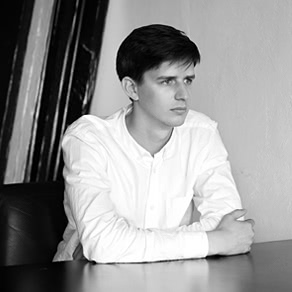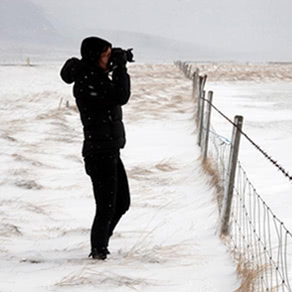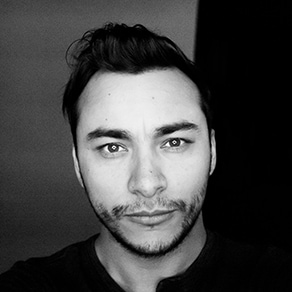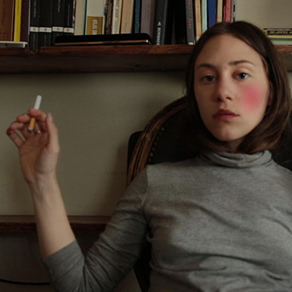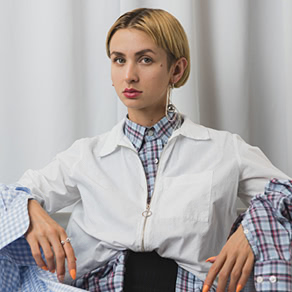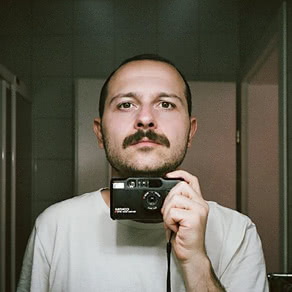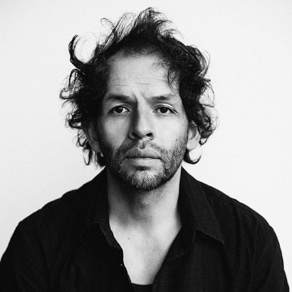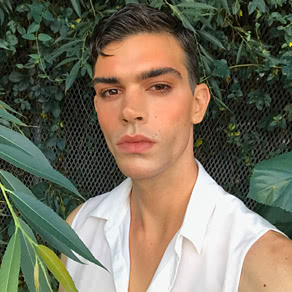
|
Format |
|||
| Format |
Nizo enhances the power of iPhone’s camera to cinematic effect and distills filmmaking to its purest form. 1080p
1920×1080 4K
3840×2160 |
||
|
4K
3840×2160 1080p 1920×1080 |
Various Format | Features |
Shoot
Cut
Wrap
|
Jonas Lindström captured natural beauty Lea Roesch in a hyperreal natural environment set to an intimate ambience of breath. Strikingly simple, structured garments contrast with organic movement.
Filmmaker Profile
Director: Jonas Lindström
Starring: Lea Roesch
Assistant: Timothy Schaumburg
Music: Cedric Dekowski & Felix Reifenberg
Taking his cue from the ambient rhythms of an orchestra tuning up, Jonas Lindström presents an oneiric collage of light, landscape and natural beauty for Nizo, starring Lea Roesch. Here, he talks contemporary tools, cinematic sketches, and the challenges filmmakers face today.
What is it about filmmaking you love?
Visual, Pace, Narrative, and Sound – everything coming together in one moment. When done right, it can create a direct emotional response – this sudden impact is what I enjoy.
With today’s tools is creating a film any easier?
Filmmaking will always be hard. Access to the tools is now easier, but making a good film still requires a lot of effort. The least of your problems is the technical aspect of the gear. Creating a film differs from the common ‘everybody can be a photographer nowadays’. Films need many elements from different angles all coming together.
But it’s exciting the tools in the palm of our hands are powerful enough to allow people to produce good moving-images to fulfil independent filmmakers needs. It’s a great enabler. And can help make things simpler for people already making films.
What was the inspiration for your film ‘Study 01’?
The sound inspired the film. This disarranged harmony of an orchestra tuning, with the creative elements flowing around not yet in their proper place, but still beautiful in their own right. I tried to recreate that in the images. Which matches the way you shoot films on your phone – small, beautiful sketches, cinematic notes, loosely arranged fragments that work more like a sketchbook, a diary.
What was inspiring or challenging about shooting the film on an iPhone, with Nizo?
Gear for filmmaking is heavy, slow, lethargic. What I love about photography, this quick, direct way of responding to a situation, I loathe about filmmaking. It requires more effort, manpower, and preparation to get a good shot, and is not that spontaneous. Nizo and the size of the iPhone enabled us to work with fast responses to moments that appeared in front of our eyes, unusual camera angles, new perspectives. This was inspiring.
A stark, moving portrait where lacy lingerie contrasts the stoic wax sculptures of Sarah Roshem. High fashion editorial meets experimental performance art in Stas Kalashnikov’s film, starring model Maya Coline.
Filmmaker Profile
Director: Stas Kalashnikov
Model: Maya Coline
Stylist: Melodie Zagury
Artist: Sarah Roshem
Russian-born, Paris-based photographer Stas Kalashnikov conjures an otherworldly scene in ‘SR Labo’, marrying art and fashion. Here he discusses the film, creative collaboration, and the power of Paris to realise artistic ambitions.
Describe your aesthetic.
I love everything natural and pure. I shoot by myself. Visual effects, a big team, and set design are not my style. My art is about personality, real life, and people, how they look in reality.
How has moving from Moscow to Paris influenced your work?
Paris is where I grew up as an artist and developed my style. I moved to Paris four years ago not knowing what I wanted to do, but curious to experience this inspirational city. It’s amazing, meeting people who inspire me every day and I am grateful to them. Paris has become my home.
You collaborate with stylist Melodie Zagury what is your creative process?
When I first met Melodie, I didn’t speak English. We worked together on a large magazine commission; the project turned out beautiful. After that everything moved fast, we collaborated often and created art projects for ourselves, because we loved it. Melodie is like my sister now. She understands what I want to achieve; we share ideas, and she has great taste. Collaborating is always fun, we explore concepts based on how we feel and have been happy with the outcome.
Melodie and you have since founded Alei Journal, how did you both start a magazine?
After a year of working together, we created Alei Journal. The journal began with a website and Instagram. Soon after we produced our first printed publication with our good friend and designer Daphne Mookherjee. We collaborate with young talent, artists, and designers. Showcasing photographers we love – along with installations and exhibitions. We are planning our fifth issue, and Alei Journal is available worldwide.
Where did you draw your inspiration for ‘SR Labo’?
SR Labo was a collaboration with one of my favourite artists Sarah Roshem. Sarah is a French artist, ShR Labo is her research laboratory focused on living beings, their environments and healing through experimental instruments, realised through her wax sculptures. We met often over the past few years and share the same aesthetic. I love what she creates, how she uses unusual materials to produce her art.
We filmed on location in Sarah’s atelier, in the space where she works, lives and draws her inspiration. I tried to make the video express how I see her art. Model Maya Coline wears several of her pieces in the film.
Is technology changing the way you make films?
Now you can shoot a movie with your iPhone. It makes my artistic process and production faster and easier. To create something natural and beautiful, you don’t need a lot; grab your iPhone, write a little plan – then go!
That’s why I find Nizo useful. It’s easy to use and the presets all make for natural filmmaking – they are not too much if you know what I mean. It’s fun to shoot with Nizo, you can shoot clips and even edit on location to see your film at that moment.
Interview by Vicki Tourtouras
WILK rigged an iPhone to a DIY self-mounted POV rig to shoot this confrontational music video for Jack Ladder’s ‘Reputation Amputation’. The result: a jittery, unsettling closeup of the artist in motion, replete with a leaf blower to the face.
Filmmaker Profile
Director: WILK
Starring: Jack Ladder
Stylist: Aline Joyce
There’s a visceral, dynamic energy that underpins ‘Reputation Amputation’, WILK’s music video for Jack Ladder and The Dreamlanders. It’s born out of the Australian photographer’s appetite for subverting traditional techniques – if it stays with you long after you turn away, he has succeeded in his aim, he tells Nizo.
You have created portraits and films for musicians such as Sarah Blasco, Flume, Goyte, and Killing Heidi. You mentioned your aim is to express both the artist and their music through the image. How do you go about doing this?
I listen to the artist’s music at length. Also, I try to spend as much time with the artist beforehand. Whether that’s us brainstorming or socialising together. Anything to build up a rapport.
What is it about filmmaking that you love?
It’s a similar, but more complex love than my love for novels. In this case the ability to use sound, picture, and language – to create believable characters and stories that reach inside us, to make us feel and think. To take us to a world that doesn’t exist, whether fictional or a place we’ll never experience for ourselves. To tell a story that connects with people and moves them.
How is your approach to creating music videos different to your photography?
Videos need much more focus on structure and pacing. As an initial concept usually has to evolve or vary. The initial conceptual inspiration process though isn’t that different.
How do you think the newfound accessibility of making independent films is changing the world?
There is a lot more content, everybody is having a go. The interesting or exceptional work is still a small percentage. As David Lynch said; ‘Everybody and his little brother has a piece of paper and a pencil. But how many great stories have been written on that piece of paper?’ At the very least, young people and independents can have a go, and everyone else... hopefully will become more visually literate.
Tell me about your concept for ‘Jack Ladder and The Dreamlanders’ music video ‘Reputation Amputation’.
The idea was to create a confrontational, spasmodic music video. Inspired by the song’s lyrics, 80s MTV, and the character Max Headroom. Twitchy and confronting. Using the song’s title ‘Reputation Amputation’, it seemed fitting the singer wear a rig that used selfie sticks to support the camera and lighting. I made the rig from PVC pipe, rope, a belt, an LED with a red gel attached and a few selfie sticks. It’s a selfie video gone to hell.
You’ve shot with many camera’s and formats from the Hasselblad medium-format, Polaroid to digital. How did you find shooting with Nizo?
The way the iPhone camera sees, or its focal length and aberrations are quite unique. Nizo’s immediate grade and capture are great, along with the intuitive workflow. To capture on such a small and lightweight camera with ease and flexibility made the tool perfect for the concept. I look forward to the next wave of iPhone and like-minded phone cameras.
Your work explores in-camera techniques. What attracts you to this way of working rather than the more common approach of digital editing in post?
I’ve never been good at post work. And when viewing it I’m always left feeling empty. I like using the limitations of cameras to effect. You end up with original unique viewpoints as usually everyone is striving for perfection. So at least it’s a separation point as well, hence my interest in this project. I think originality is more interesting than perfection. Finding a unique way to tell a story visually is far more intriguing than a slick well-produced work. Especially as cameras and algorithms are making quality so much easier to obtain.
The eye follows the ripples, but the ear hears each raindrop as one continuous white noise. Polly Stanton’s spontaneous cinematic gesture filmed at Mt. Macedon during a winter storm is an edifying moment of zen.
Filmmaker ProfileBridging the divide between what we see and how we hear it, audio-visual artist Polly Stanton creates work which investigates the power of cinema to shape human experience. Of which her new film ‘Lake Sanatorium’ is a fine example; a meditative reflection amplifying nature’s profound ephemerality. It’s an instinctive way of working, the artist explains.
Tell me about your passion for sound.
As a moving-image practitioner, I’m between both sound and vision, navigating a transitional space between the two mediums. The expansive nature of sound and the practice of listening have always played an important role in my work. The more I work with the audio-visual, I’ve discovered that listening is an essential tool in the way I document locations. It points me toward what to look for in the field, where to focus my camera and how to edit in the studio. To listen is a medium of feeling pause, a speculative situating and a means to be bodily affected by the locations I traverse. It draws my attention from behind the camera into the larger world, implicating me in the environments I document.
Walk me though a typical day of sound research in the field.
My first day of fieldwork is without equipment. I walk, listen and look at the surrounding location. This way I get a feel for the place and the environment becomes accustomed to my presence. My work takes time, projects can take up to a year. This durational field research is a vital part of my practice. It’s where problems, failures, questions and new ideas are forming.
Is your art scripted or responsive?
Seldom is my work scripted, it’s a spontaneous and open process. Working in the landscape is difficult. It requires letting go of expectations and working with what presents. Nature is uncontrollable. From light, to sound, to weather, the constant array of unforeseen happenings form a fluctuating assemblage of stimuli. The less I expect from a place the better my relationship and the more freely I can listen and look. In this way, landscape is slippery and defies expectations. It takes a certain intuitive understanding to know how to approach a landscape. I learn where to point my microphone, when to press record, or when to just sit still and listen.
Which comes first, image or sound?
As much as sonic practice is an important focus in my work, I don’t feel one medium dominates the creative process. Audio-visual is a relationship that entangles the senses of sight and sound. It’s a complex play of relations and tensions, each expanding and supporting the other.
How is mobile technology changing film?
It’s given people like myself the opportunity to make work independently. And expands our collective understanding of what cinema can be.
Tell me about creating your film ‘Lake Sanatorium’.
Experimenting with the portability of the iPhone and how Nizo might change my way of working in the field was exciting. I work on long audio-visual projects in isolated landscapes, so working with Nizo offered me a break from my usual mode of production. I filmed things as they occurred making sure I had my phone whenever I ventured out into the environment.
The work took place during a winter storm in a location that would have been difficult to access with my usual camera and sound equipment. I documented the ephemeral and obscured nature of the location, juxtaposed with the tactile and meditative sound of the falling rain.
What do you enjoy about shooting with Nizo?
Being unencumbered by equipment feels great. It doesn’t allow you the control that a professional camera offers. However Nizo gives me spontaneity in the environment and a way to help me think outside my normal work-flow. Nizo made me rethink my ever-expanding camera gear and helps me pare things down so I can be lighter and more impromptu in the field. It’s also great for creating sketches and ideas for larger work or documenting a site for later.
Interview by Vicki Tourtouras
A deep, dark exploit in the corporeal, Justin Ridler’s short film opens on a body in metallic breastplate, writhing on the floor. Surreal minimalism accentuates dancer Alisha Coon’s visceral performance, immersed in a heavy ambient soundscape.
Filmmaker Profile
Director, DOP: Justin Ridler, Hart & Co.
Performance: Alisha Coon
Hair & Make-Up: Kylie O’Toole, Hart & Co.
Costume: Onix Black
Music: Nick Whales
The creative experience itself comes under scrutiny in Justin Ridler’s dynamic exploration of what it means to make images, starring dancer Alisha Coon. It’s all about movement, he tells Nizo – and doing whatever you need to capture that.
What do you enjoy about filmmaking?
I find that viewing a film is less subjective than viewing a still because the medium works with narrative. That’s marvellous for me, as I can be more definitive in the way a viewer will understand my concept.
How do you think accessibility is changing independent filmmaking?
It democratises the filmmaking process and makes it easier to work nimbly. I like the ease of shooting a film with Nizo on my iPhone – I can test out an idea with something that’s always in my pocket.
Tell us about the idea behind your film ‘Mercury’.
I wanted to create a futuristic low-fi allegorical metaphor for the creative process.
What did you find inspiring or challenging about shooting the film on an iPhone, using Nizo?
The user interface of Nizo is so cool – I enjoy how focused the app is. It becomes all about the image. Using consumer technology to create a film took me out of my comfort zone and got the brain working.
As for challenging, shooting in a hot Melbourne studio with three tethered iPhones. To capture Alicia’s performance from above, we rigged an iPhone to a jib several meter’s overhead as she danced on a rotating floor. The higher temperature in the ceiling caused the device to overheat.
Andrea Sisson’s bedroom romp with performance artist Christen Quattlebaum juxtaposes hard edges familiar of a NYC apartment with the softness of a girl’s personal sanctuary.
Filmmaker Profile
Director: Andrea Sisson
Dancer: Christian Quattlebaum
Art Assistant: Milan DelVecchio
Fashion: DEGEN
From contemporary art to narrative film, Andrea Sisson’s nuanced combination of philosophical theory with modern, multidisciplinary storytelling has garnered an impassioned following. “Art reflects a time and place,” she tells Nizo – a clue to the concept behind ‘Girl in this World’, her subtle takedown of patriarchal ideology, starring performance artist Christen Quattlebaum. The artist explains.
Your art is an exploration and expression of your anthropological and philosophical observations of society. Where does this passion stem from, and what is your responsibility to it as an artist?
It comes from my interest and experience with mental illness. I have a sibling that suffers from schizophrenia and my older brother is deaf. People who struggle, often think deeper about life. I explore societal perceptions and beliefs, the challenge of seeing and helping others to see from new perspectives.
In college, I travelled to Italy and lived in Iceland. I learned these cultures did not share the American perspective and the way we live our lives. People were not discriminatory about mental illness, female body issues, eating disorders, and gender. Misogyny in Iceland is rare, men and women are equals. So I realised, that ‘the way things are’ is not ‘the way things are’ at all, but only ‘the way things are’ in a certain context.
You co-directed with Pete Ohs the feature film ‘Everything Beautiful Is Far Away’ starring Julia Garner and Joseph Cross. Describe your process creating the character’s world set in the remote Glamis Dunes of California.
The film world is a metaphoric scene. A philosophical landscape rather than sci-fi inspired. The concept for the aesthetic was to minimise stimulation and maximise inner thought. The colour palette reflects the desert, making the characters one with the environment. Pete’s script described the characters objects and scenery. He also made an animatic with detailed drawings. The objects are quirky and futuristic, yet handmade because Lernert (the main character) made the tools himself.
I’ve since noticed art reflects a time and place. The sun bleach of my new LA environment and leftover Scandinavian influences made their way into the film. Pete influenced by ‘classic filmmaking’ adopted a simple 1940s movie-making approach. A light airy feel, the language, and shot development. And so Lernert in his green army attire emerged from movies. He’s a movie character, even has a transatlantic accent from that era.
In ‘Everything Beautiful Is Far Away’, Lernert programs Susan the robot to ‘miss’ him when she’s shut down. Do you think future AI, will have traits such as gender bias from their creator?
AI reflects the humans that make them. Lernert programed Susan to accommodate his own insecurities of being alone. We could avoid gender bias – but this needs a conscious approach, which I don’t see happening. Amazon made the Alexa with a female name and voice. You say: ‘Alexa, do this, do that’. Every time I hear this I cringe. It’s a female servant?! Why is it not gender neutral?
We need strong forums of consciousness to change our course, which I’m hopeful is happening with the ‘Me Too’ movement. But, I’m not sure people are aware or thinking about their ingrained perspectives. I’ve heard someone say ‘Alexa, I fucking hate that song, don’t play that again b—tch’.
Tell me about your film ‘Girl in This World’.
My inspiration for the film came from German philosopher Josef Pieper’s critique on our ‘leisure-less’ society. Peiper believed that the workaholic mindset of today’s culture is counter-productive. He postulated;
‘The original meaning of the concept of “leisure” is almost forgotten in today’s “leisure-less” culture of “total work”. Leisure is only possible in the assumption that man is not only in harmony with himself… but also in agreement with the world and its meaning. Leisure stands in a perpendicular position of the working process… Leisure is not for the sake of work, no matter how much new strength one who resumes working may gain; leisure in our sense is not justified by providing bodily renewal or even mental refreshment to lend new vigour to further work…’
Pieper described leisure as the founding principle of campuses and libraries. Leisure opened the mind to intellectual ideas, deep thinking and discovering.
‘Girl in This World’ is specific to youth perspectives, feminine sensitivities, identity, and experience. The youth has forward and world-changing perspectives. We need to listen to, respect and see the change they are embodying. I featured DEGEN clothing because she is a fashion designer that celebrates body acceptance of all kind.
How do you think filmmaking is changing with mobile phone technology?
It’s changing everything. Today’s youth are sharing their stories and perspectives with no need for permission or a lot of money. Filmmaking is more accessible, no longer what the market dictates, but can be for activism, expression or voice alone. It’s also transforming how long a film takes to make. Feature and indie films take years. But, the best thing about creativity is how relevant it can be to current culture. Something creative now has the potential to be relevant and be part of the cultural and social dialogue.
Interview by Vicki Tourtouras
At the intersection of the worlds of fashion, art and movement, ‘Soft Matter’ explores the theme of personal identity, personality and emotion, seeking to translate a rhythm of expressing oneself with a deeper meaning.
Filmmaker Profile
Concept, Art Direction & Editing: Anna Malá
Camera: Tomas Janicek
Sound: Jakob Schlötter
Based in The Netherlands, stylist and art director, Anna Malá, is constantly on the search for visual inspiration. Combining fashion, art, food, flowers, interiors and still life, Malá has crafted a unique aesthetic that is design-led yet natural and unexpected, exploring themes of identity, improvisation and self-expression. Here she tells us about her very first film entitled Soft Matter.
You studied spatial design at Tomas Bata University and textile at the Art Academy in The Hague. So what is your relationship with fashion and architecture design now?
Fashion and interior architecture continue to be my big passions. Even though I didn’t become an interior or a fashion designer, I can relate to both. I have a different relationship with each of these disciplines – architecture calms me down and fashion turns me on. Now I understand both obsessions come from an interest in specific aesthetics, which don’t apply only to one field or profession. I am drawn to style; I like to touch things and make them look the way I want to.
So that explains why you became a stylist after your studies – tell me more about that?
After my studies, I worked as a commercial stylist. I considered it something that paid the bills and didn’t plan on pursuing it any further. As I worked on more exciting projects, I realised I could work with fashion without making the clothes. My first editorials were for fashion graduates of The Royal Academy in The Hague as I knew them from my studies. I styled shoots for the department’s annual magazine and worked with designers from the collective Das Leben am Haverkamp. Schön! Magazine, Fucking Young, Glamcult and Sixth Finger Magazine have published my work.
Styling is about translating and conveying ideas, what does it mean to you as a profession?
For me, styling, or expressing oneself through clothes is freedom and breaking from conventions. It goes beyond putting a great outfit together. Being clothed is so intertwined with one’s identity and loaded with meaning. I’m interested in creating tension and contrast, in references, silhouettes or colours.
About breaking free from conventions, are there any designers who have inspired your passion for fashion and how to express oneself through dress?
Martin Margiela. I think he’s a true genius; he was a pioneer in challenging the fashion system, which more designers are doing nowadays. What inspires me is his way of looking at things. He dared to approach things in a different way, not favouring people and not answering to industry standards. There is something sincere and genuine in everything he did. His ‘All White Show’ in 1989 is one moment in fashion I wish I could have experienced.
You’re also an art director, so how do you define yourself, what comes first?
I work as a stylist, but I’ve also worked on personal and commissioned projects as an art director, creating imagery and video. Art direction is the most important part for me and how I want to spend most of my time, it’s what gives me the most satisfaction. I can express myself totally and other people can also add to it.
And you’ve directed the film ‘Soft Matter’ for Nizo using the iPhone – from concept through to direction and editing.
I am very excited about film or let’s say moving image. When editing I could see a parallel with dancing because you create a rhythm. I played with building tension, creating a silent or an intense moment or a sense of emptiness.
What is the concept behind the film and your main reference points for it?
‘Soft Matter’ is a visual metaphor for a discussion with oneself. The two characters in a blond and a dark wig represent different sides of one’s personality. The reference was personal as at the time I felt detached from myself. I wanted to express the search to recognise my own emotions. I left quite some space for improvisation, as intuition and improvisation are my strengths, and I get high from working in the moment.
Where was the film shot and why did you choose that place?
We filmed in the early morning at a playground next to my house where I go to relax. I find myself attracted to the playground because it’s like a place from outer space. I like how abstract it is, it invites you to play without being clear what to do there.
What was the most challenging and best part of making the film with Nizo?
I’m not normally the editor so the editing process was the most challenging and best part of the process. Nizo enhanced my control over my images. The challenge was to come up with a way to build up an interesting tension, which I achieved by duplicating and trimming of the same sequences.
What was your favourite part of the project?
When we added sound. My friend Jakob Schlötter made the sounds. These include operating noises from a stationary fan, breathing sounds and friction of rubbing skin. Raw and manipulated samples using granular synthesis techniques to match the desired atmosphere. The dynamic and storyline are supported by linking sounds to the reappearing abstract and figurative visual personalities.
How do you think social media apps have changed the world of art, fashion and filmmaking?
There was a naïve period when the internet felt innocent. A sense of freedom and liberation where artists did things on their own terms and didn’t depend on a handful of people in power. But in time social media became strategic, calculated and manipulated. I am not sure about other disciplines, but in fashion, it helped to develop this environment of irony and cynicism. It’s fun for a while but sometimes it feels like nobody cares anymore. Fashion is a three-dimensional and very sensual experience. But through social media, clothes only get presented as a flat image. Perhaps this is why we want more - because we don't truly experience things anymore. Not to sound cynical - the internet is a great and exciting place. I just wish continuity, quality, and sustainability would be cool again.
So in pursuing your own creative route, what is your no-frills advice to those looking to do the same as you career-wise?
Don’t conform to how people expect you to be. I learned that the personal things I’ve made resonate the most with people.
Interview by Kate Lawson
Transgender singer Kübra Uzun moves through an imposing Istanbul hotel room in this sensual short, singing of love and longing against the backdrop of a beautiful but unsettled city.
Filmmaker Profile
Director, DOP & Editor: Harun Güler
Starring & Vocal Performance: Kübra Uzun
Colorist: Simone Schreiner
Sound Design: Candaş Erdener
Music: “Şarkılar Seni Söyler” (Muzaffer İlkar, Fakih Özlem)
Special Thanks: Tuğba Doğan, Kübra Yavuz, Sascha Jörres, Becker Schmitz
There’s a skin-prickling power to the work of filmmaker Harun Güler, who pairs a profound passion for the Turkish music of his parents’ homeland with a subversive appetite for challenging established norms in both art and society. His resonant short ‘Room 2740’ sees these two themes collide in an imposing Istanbul hotel room, to unforgettable effect.
Tell me about your love of music.
Turkish music is my great passion. My parents moved to Cologne from Turkey before I was born, but they didn’t speak much German, even after so many years there. So while I consider myself German, I feel very connected to Turkish music. Deep down I always wanted to be a musician, but my parents did not support that. Now, I make a lot of music videos, and I think this is an alternative way for me to connect with music.
How did this inspire your ongoing series ‘Maqam’?
‘Maqam’ is a system of melody types. Turkish music works differently to Western classical music; every composition is based on a different melody type, of which there are between 100 and 150, and evolves to form a different song. At the moment, only 20 maqams are frequently used, and I wanted to play with the idea that each one has its own emotional world.
People feel this music profoundly – some maqams are emotional and dramatic, others are more up-tempo and positive. When I was doing my MA, I had the idea to create films based on them. I see it as a never-ending project.
What draws you to working in slow-motion?
When you watch a moment in slow-motion, it opens up a whole other emotional world you can’t see in real time; that place between still and moving image. It becomes very sensual. My references are usually photographs, and my aim is to make moving images, in a way.
I love to push the boundaries of every category: when I do video art, I always try to incorporate an element which is not directly connected to the genre. I’m working on a multi-channel video installation at the moment, and I’m still experimenting.
What inspired your film ‘Room 2740’?
One of my friends, Kübra Uzun. She’s transgender, and a singer, and lives in Istanbul. I focused during my studies on gender performativity, and I always try to challenge binary stereotypes. I came to her with the maqam idea and she selected a couple of songs and decided to sing this one. The lyrics are: ‘Songs sing about you; your name is the lyrics; just like love, just like longing; a grumpy and sweet woman’. I thought it was perfect.
Where did you shoot it?
We rented a large hotel room in Istanbul, where we shot for the whole night. I love the reflective properties of the glass and the mirrors. There’s something about hotel rooms – I think it’s their isolation, the feeling of being alone, that draws me. I love liminal places, where things are not defined. I always want to push my works into a liminal space – so that from the beginning, people don’t know exactly what genre they’re watching.
Interview by Maisie Skidmore
Brewed from dark dreams and seductive surrealism with a hint of eroticism, ‘Morpheus’ is an unnerving but enticing tale where reality and fantasy clash, to delve beneath the surface of the human condition.
Filmmaker Profile
Director, DOP: Christopher Polack
Stylist: Kristie Klein
Hair: Barney Gleeson
Make-up, Masks: Ben Dniprowskij
Model: River Johnson
Sound Design: Joris Tilman
Photo Assistant: Cam Cooke
Fashion: Atelier Harlem & Dolls Kill
From the still image to the moving image; it is the dynamic storytelling in Christoper Polack’s work, which seductively immerses the viewer in a moment where drama and emotion collide. From highly stylised glamour to a raw and unpolished aesthetic, Polack’s dark and minimalist approach visually stirs the senses. Kate Lawson spoke to the artist about his new film ‘Morpheus’ made in collaboration with Nizo.
You were born in Australia and now live between London and Melbourne – where do you feel most at home?
Wherever I hang my hat.
What led you into photography and what were you doing before that?
I was riding freestyle BMX and touring around the world, which is when I first picked up a camera and started to take pictures and submit them to BMX magazines, which then led to establishing my own publication. I then pursued fashion and portrait work, while working in film at the same time.
Is that when you worked alongside two of the greatest storytellers in film – George Lucas and Baz Luhrmann?
I worked at Panavision [the motion picture equipment and production company] as a camera technician and worked on location to assist production crews. At times I would be standing next to one of those great directors and pick up a few tips along the way. Watching them at work taught me a lot about directing.
You also completed a mentorship with Nick Knight, how was that?
It was a really amazing opportunity to have my work challenged but also to help me learn more about the business side of the industry. I was also able to showcase my work on SHOWstudio and with Vogue Italia, among others.
How would you define your aesthetic as a visual artist?
Raw, dark and sometimes cheeky.
You shoot predominantly in black and white, why is that?
Real life makes things beautiful in colour. I don't always want to replicate life, instead play out my fantasies and dreams (or even nightmares). I work best with limitations and restrictions in my process.
Storytelling is key to your work – how do you bring deeper meaning to the narrative?
Depending on the brief or the reason for shooting, I’ll often allow an emotional connection or experience to lead the journey. I love the human form, so pairing that up with a garment allows me to explore some kind of harmonious relationship between the two. Sometimes it’s about meaning, sometimes it’s purely about aesthetics. I would love to say, I want to challenge the perception of beauty but I don’t want to sound too clichéd! If anything right now, I probably seek to challenge my audiences perception in any way I can. Sometimes it’s about social commentary, sometimes it’s about dreams.
Talking of dreams, tell me about your new film ‘Morpheus’?
The story is to make of it what you will, to let audiences interpret it as they wish. Morpheus is son of dreams and also son of sleep. To dream is to be aware of a fragmented, disconnected reality during rest, but if we don’t dream (or remember), does that mean it did not exist? In the science of dreaming, it is the universal law that we can all experience our own virtual reality and that our desires and fears not be judged or scrutinised in the world of consciousness.
How did the concept for the film come about?
I developed the concept in 2017. I had been experimenting with the idea of making visual stories without any dialogue and using this method would fit a fashion film perfectly.
There is a stylised aesthetic to the film which is quite past vs present, where was it shot?
In the Penthouse at the Hotel Windsor in Melbourne. I wanted the setting to nod to an old world so we could achieve a contrast to my character who I envisioned as contemporary and progressive. I love to clash worlds.
Your character wears latex in the film. Which designer did you use?
Atelier Harlem, a great Melbourne-based designer and the shoes were by Dolls Kill, from their Current Mood collection.
So in terms of creative inspiration in your own world, who are your heroes?
All my heroes are dead. Irving Penn, Bill Brandt, May Ray etc. But I also like what contemporary artists such as Banks Violette are doing.
How are you inspired on a daily basis?
Lately it’s been about sitting still. Staring at the wall and allowing the ideas to manifest. I’ve also been enjoying life with friends and family and travelling, being on the road helps to inspire me.
How do you think the photography world has changed with people having access to a great quality camera right from their phone?
Photography has evolved yet again, due to iPhonegraphy – we’re seeing a new kind of photographer evolving. One less about technical know-how and more about ideas. That’s exciting. I think photos and motion will be lead by ideas even more in the near future. More then ever due to the fact that everyone in the next few years will own a high powered machine capable of producing broadcast quality imagery.
What’s the best advice you’ve been given?
You can unlearn anything and learn everything.
What’s next for you?
Right now, I’m making plans to drive through the middle of Australia. 5000km right through the red centre with my girlfriend. Laying under the stars each night and jumping into lakes and rivers. I’m going to be shooting along the way and making it into some kind of project in the future.
Interview by Kate Lawson
Urban behemoth New York City plays host to a cast of contemporary dancers in Derek Johnson’s new film, a paean to the poetry of movement.
Filmmaker Profile
Directed by: Derek Johnson
Starring: Quinton Mulvey, Cameron Lee Phan, Ashton Lang, Adam Warner, Luke Smithers, Carmen Julia Duran Garcia
Transitioning from editorial fashion photography to film, New York-based artist Derek Johnson has carved a space for himself creating powerfully resonant moving tableaus. Here he tells Nizo about ‘In and Out of NY’, the new piece that has taken him in a refreshing new direction.
How did you first start working in film?
I went to the School of Visual Arts in New York City to study Photography. While I was there, my work was scattered within the realm of fashion photography, but the moment I graduated I started to transition into filmmaking. The referential information I had in fashion photography influenced my work later on; I was translating that editorial work into film. I found that working with time and movement took those images to a different level.
Your films often take the form of a moving image tableau – somewhere between a still photograph and a film.
That grey area was important, especially when I was starting out. I didn’t have the resources to use a DP or a Steadicam operator, so the tableau format emerged out of necessity – I was putting my camera down on the floor, and directing the model to move.
How do those two worlds compare?
The film and fashion editorial worlds are at odds with each other. I think film can be very heteronormative; it’s techy, it’s production-heavy. That sense of humour, the lightness, the absurdity of fashion isn’t there. So being able to marry the technical knowledge that goes into a film, with the body of reference and the spontaneous approach of a fashion photographer, that felt very fresh to me. We put all the elements in place – the styling, the talent, the location – but then we let it happen. You can’t force it.
Can you tell us about ‘In and Out of NY’?
With this project, I was interested to let go completely. I had a phone, I had a little handheld Gimbal – I was excited not to be encumbered whatsoever. That way I could be a participant in the movement and with the models – it was so literal, so spontaneous, so participatory. I wanted to facilitate that sense of discovery with the medium itself. I cast people that I knew I’d be comfortable with, very close friends who were very giving and free, and picked the locations, and let things happen. It all starts with a certain gesture, a movement or a space, and you let it go from there.
The soundtrack to the piece is so disjointed and atmospheric. How did you create it?
I put the film together silent – I feel like I can see the rhythm in the gestures and the movements better – then I created the sound to match it afterwards, layering things up from a library of sounds. I’m obsessed with interior spaces, and I didn’t want too much identity in the music because it’s such a visual piece.
Interview by Maisie Skidmore



